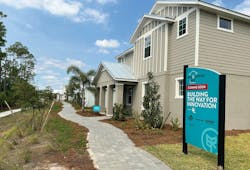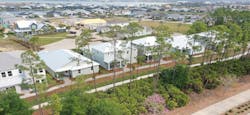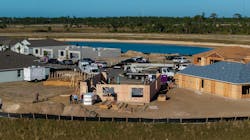From a sprawling 18,000-acre site near Punta Gorda, Fla., north of Fort Myers on the Gulf coast, the planned community of Babcock Ranch will eventually house more than 55,000 people and aims to be a model of sustainability that generates at least as much energy as it uses.
Florida developer Kitson and Partners is eagerly adopting new technologies, materials, and systems to boost sustainability and resiliency within the community, encouraging its home builders to test innovative products for home construction beyond their current production and performance boundaries.
Case in point: D.R. Horton, the nation’s largest home builder, broke ground in December on five pilot homes that will incorporate panelized engineered wood framing, small-diameter HVAC ducting, wood-fiber insulation, and smart/connected lighting systems to gauge how they perform in the field.
As important, the project team will monitor the ease of installation, labor costs, consumer response, marketing messages, and any other factors that help determine the feasibility of these and other innovations to scale up within Babcock Ranch and across the industry.
A Living Lab for Testing Building Products
Kitson and Partners is offering D.R Horton and other builders at Babcock Ranch a rare opportunity to test products that can improve quality, sustainability, and ease the costs of building new homes at fairly low risk and without overly disrupting their established production processes.
“Builders have great ideas on the boards but don’t always have a sandbox in which to test them,” says Tom Hoban, president and chief investment officer at Kitson and Partners. “Babcock is like a living lab. Our intent is to influence change in the industry.”
While the firm has uncommonly ambitious sustainability and resilience goals, it works cooperatively with builders, manufacturers, and utilities to find solutions amenable to all parties.
“Not everything is going to work,” Hoban says. “It doesn’t make sense to force builders to do what doesn’t work financially for them.”
In a risk-averse industry in which change happens incrementally, field testing new products and techniques in a real-world building environment suits builders with an innovative bent, allowing them to discern feasible solutions from those that aren’t ready for prime time or are unworkable.
Kitson and Partners understands the challenges of innovation, says Josh Graeve, president of PulteGroup’s southwest Florida division. “When we try a new product, we are looking for an owner that has supervision over construction, provides attention to detail, and has a passion for excellence.”
A Catalyst for Home Building Innovation
The developer fits that profile, acting as a catalyst for innovation in a few ways.
Since groundbreaking at Babcock Ranch, Kitson and Partners has sponsored two innovation workshops, inviting manufacturers to introduce and showcase new products for its Babcock Ranch builders.
The latest event, held in 2022, included presentations on 3D printing, robotics, and panelized framing systems.
Some of the innovations highlighted during these workshops have been employed in two pilot home projects. The first one, called Innovation Way, kicked off in 2021 with participation from D.R. Horton, Pulte, and Lennar—the top three builders in the country by revenue and closings—for which the developer provided the lots free of charge.
“Builders have great ideas on the boards but don’t always have a sandbox in which to test them. Babcock is like a living lab. Our intent is to influence change in the industry.” —Tom Hoban, president and chief investment officer, Kitson and Partners
Pulte’s pilot home included an electrical infrastructure that allowed a full-size, all-electric Ford F-150 pickup truck to serve as a battery storage device for surplus energy generated by the community’s 150,000-megawatt solar array—enough to power the home’s energy-efficient heating and cooling system and appliances for five to seven days. The project gave Pulte and Ford real-world data on the effectiveness of using an EV as a backup power source.
Rolling out new construction products can be a years-long process, and pilot projects like those initiated at Babcock Ranch can smooth the way to widespread acceptance.
For example, the developer first came across BamCore’s panelized engineered wood framing system in 2020. The products, DuoShear and MonoShear, had to gain building code approvals from state and local governments in south Florida to comply with strict hurricane-resilient building codes before they could be used.
A departure from the regional habit of using concrete block to frame a home’s first story. BamCore’s wood framing products proved during lab testing that they could withstand up to 170 mph hurricane-force winds and protect against the projectiles they generate.
For the five-home pilot project that kicked off in December, D.R. Horton’s use of BamCore’s framing system at Babcock Ranch was the innovation’s coming-out party in Florida. The testbed gave building inspectors the opportunity “to see, touch, and feel the product on the jobsite and gave them experience with inspections,” says Lucienne Pears, VP of economic and business development at Babcock Ranch.
The experience also allowed the builder to give local trade partners the ability to learn how to assemble the system and gain proficiency in a production setting, quickly reducing labor time and costs.
“We had the walls and trusses up and the roof sheathed in 3 hours” says Damien McBrien, director of innovation at D.R. Horton. “It would take at least a day or two to get to that point building traditionally.”
RELATED
- Video: Building With Bamboo: An Interview With BamCore's Zack Zimmerman
- Material Innovations for the Hands-On Builder
- Housing's Incremental Innovation Path
Educating Homebuyers and Trades on New Methods and Building Materials
In addition to the insights gained by the project team, trades, and suppliers, the pilot homes also will give prospective homebuyers exposure to wood-framed structures in an area where concrete block construction prevails, an important educational opportunity to help shift their mindset.
“There’s the perception that, like in the three little pigs’ story, concrete is more durable [than wood],” McBrien says. He’s hoping this showcase of test homes can change that notion.
Compared with concrete block, BamCore’s solution offers a thermal advantage that is enough to reduce typical HVAC sizing and related costs, says Zack Zimmerman, co-founder and chief commercial officer at Bamcore.
The five pilot homes also will get an energy-efficiency boost from the small-diameter central-air duct system from Rheia.
The size of the ducts enables runs to be located entirely within the home’s conditioned spaces, routed through conventional 2-by-4 framed walls, I-joists, and open-web trusses. It also purports to cut thermal loss by up to 25% compared with conventionally ducted homes, says Nigel Watts, VP-Product at Rheia.
When it comes to the sustainability discussion ... manufactures are teaming up with builders to form marketing plans that benefit them both and that enlighten consumers.
“It also tends to create more comfort in the home,” he says, while the air handlers operate for longer at lower speeds, reducing incidents of humidity spikes. “The system is also quite quiet.”
As with BamCore and the framing crews, Horton’s local HVAC contractor gained valuable (and low risk) experience designing and installing the Rheia system. Adoption of new products can hinge on the whims and wishes of key trade partners, Watts says.
“They often have a set way of doing business,” he says. Installing Rheia’s product allows for a smaller installation crew, he adds, so a contractor may have to reorganize and alter the size of its crews.
Another potential barrier: HVAC contractors invest heavily in tools and equipment to work with sheet metal ducting and may not want to get involved in a new ducting concept that eliminates payback on those investments.
The pilot projects at Babcock Ranch also enable the project team to test consumer marketing approaches for the new products and technologies.
“Buyers today are more sensitive to the sustainability discussion,” Hoban notes. Manufactures are teaming up with builders to form marketing plans that benefit them both … and enlighten consumers.
RELATED
- Marketing Industrialized Construction to Consumers
- Connected House 2.0: Getting Smart About Smart Homes
For example, part of a wall can be left open in a model home to showcase Rheia’s duct system, allowing the builder’s sales team to make that innovation part of their pitch and emphasize energy cost savings.
“While Generation Z and Millennials tend to have a genuine environmental ethos, they care most about things that are going to save them money,” Hoban says.
Today’s first-time buyers are also avid users of technology, says Derek Richardson, founder and CEO of Deako, maker of modular “plug and play” light switches, which are also being installed in the pilot homes. The switches enable homeowners to upgrade them as technology standards change, without the need of an electrician.
“In a smart home, switches are going to have to change as Wi-Fi and Bluetooth protocols change,” Richardson points out.
The company’s products can be demonstrated to prospective buyers as they tour model homes; for instance, a prospective buyer can see how a user needs only to press a single button or use an app to turn off all of the lights in the home.
“Most people have never experienced smart lighting,” Richardson says, so Babcock’s pilot homes enable mid-level homebuyers to get a taste of smart-home technology that comes standard in higher-end homes—a “wow factor” that helps makes new homes more desirable.
“We email customers a brochure on getting to know your new smart home,” Richardson says, including an offer to add more features. “We do that as an option for builders.”
Trying New Building Products With Support From Suppliers
When builders test new products in any scenario, they often look for support from the manufacturer to ensure that the product is designed and installed for optimal performance.
“We’ll work to find an HVAC contractor in the local market that is willing to give it a try,” Watts says. Rheia also has an in-house design team that can tailor a system for a particular home or provide guidance for a builder-preferred engineer and sends teams to oversee installation of its system the first time a builder uses its product.
Such close partnerships that ensure proper installation and commissioning can be crucial for a builder to get a true read on whether an innovative product has potential for widespread adoption.
Indeed, Babcock Ranch is performing a valuable service to the industry as a catalyst for innovation across several fronts. The ecosystem of the developer, manufacturers, home builders, and trades is all about gaining insight on new products that affect new-home sustainability and resiliency—and, ideally, creating a model that will trigger broader acceptance across the industry.
About the Author
Peter Fabris
Peter Fabris is a Boston-based freelance writer with decades of experience covering the housing and related industries.




